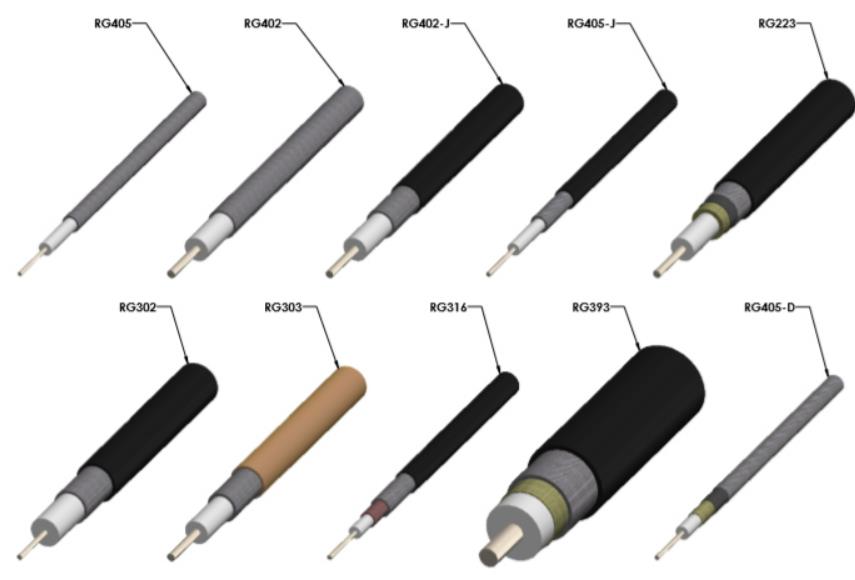Decoding the Diversity: Exploring Different Size Coaxial Cables
In the realm of modern connectivity, where signals traverse vast distances to bring us the wonders of radio, television, and the internet, coaxial cables stand as the unsung heroes of seamless transmission. These cables, with their ingenious design and precise engineering, serve as the lifelines that deliver information to our screens and devices. Within this intricate world of connectivity, the concept of different size coaxial cables emerges, each size a testament to the diverse needs and demands of modern communication. In this comprehensive exploration, we unravel the mysteries of various size coaxial cables, their significance, and how they shape our connected experiences.

1. The Anatomy of Coaxial Cables
At the heart of coaxial cables lies a simple yet ingenious design that enables the transmission of signals with remarkable efficiency. The central conductor, a solid wire or stranded core, serves as the pathway through which electrical signals flow. It is surrounded by an insulating layer that prevents signal leakage and interference. Embracing the insulating layer is the metallic shield, acting as the guardian against external electromagnetic interference. This intricate arrangement results in minimal signal loss and high-quality transmission.
2. Different Size, Different Characteristics
The beauty of coaxial cables lies in their adaptability to varying communication needs. Different size coaxial cables cater to specific requirements, offering a spectrum of characteristics that influence their performance.
2.1 Impedance and Signal Integrity
Impedance, a crucial parameter, reflects the opposition a cable presents to the flow of an alternating current signal. Different size coaxial cables exhibit distinct impedance values, typically 50 or 75 ohms. The choice of impedance depends on the application; 75-ohm cables are commonly used for video and television signals, while 50-ohm cables are prevalent in data communication.
2.2 Bandwidth and Attenuation
The size of the coaxial cable has a direct impact on its bandwidth and attenuation characteristics. Larger cables generally offer a higher bandwidth, allowing for the transmission of a broader range of frequencies. Additionally, attenuation, the reduction in signal strength as it travels along the cable, varies based on cable size. Smaller cables may exhibit higher attenuation, leading to potential signal degradation over longer distances.
3. The Spectrum of Different Sizes
3.1 RG-6 Coaxial Cable
The RG-6 coaxial cable, a familiar name in the realm of home entertainment, boasts versatility and a balance between impedance and attenuation. Its larger diameter contributes to improved signal quality, making it a prime choice for transmitting high-definition television signals and broadband internet.
3.2 RG-59 Coaxial Cable
RG-59 coaxial cables, with their smaller size, are often employed for shorter cable runs and lower-frequency applications. While they are suitable for some video and television signals, their higher attenuation levels make them less ideal for longer distances or higher bandwidth requirements.
3.3 RG-11 Coaxial Cable
For applications that demand even greater signal integrity and lower attenuation, RG-11 coaxial cables step onto the scene. With a larger diameter, these cables offer enhanced performance over longer distances and are commonly used in cable television distribution systems and high-speed internet connections.
4. Application and Expertise
4.1 Broadcast and Telecommunication
Different size coaxial cables find their niche in various industries, reflecting their unique characteristics. RG-6 cables thrive in home entertainment setups, catering to high-definition television and internet needs. In the realm of broadcast and telecommunication, RG-11 cables shine, ensuring reliable and consistent signal transmission across extended distances.
4.2 Industrial and Networking Applications
Beyond the realms of entertainment and broadcasting, coaxial cables play a crucial role in industrial applications and networking infrastructure. RG-59 cables find utility in security camera installations and other low-frequency data transmission scenarios, where their characteristics align with specific requirements.
5. Embracing Technological Evolution
As technology evolves and communication demands become more sophisticated, the landscape of different size coaxial cables continues to adapt. With the advent of 5G and the exponential growth of data transmission, coaxial cables are pushed to their limits, requiring innovative solutions to meet ever-increasing demands.
6. Conclusion: Threads in the Tapestry of Connectivity
In the intricate tapestry of modern connectivity, different size coaxial cables weave the threads that connect us to the world of information and entertainment. From RG-6 to RG-11, each size represents a unique combination of impedance, bandwidth, and attenuation, tailored to diverse communication needs. These cables serve as conduits that bridge the gap between our devices and the digital universe, enabling the seamless transmission of signals that shape our connected experiences. As we journey deeper into the realm of advanced communication technologies, the versatility and adaptability of different size coaxial cables ensure that our insatiable thirst for connectivity remains quenched, paving the way for a future where seamless communication knows no bounds.

 Mobile Signal Booster
Mobile Signal Booster